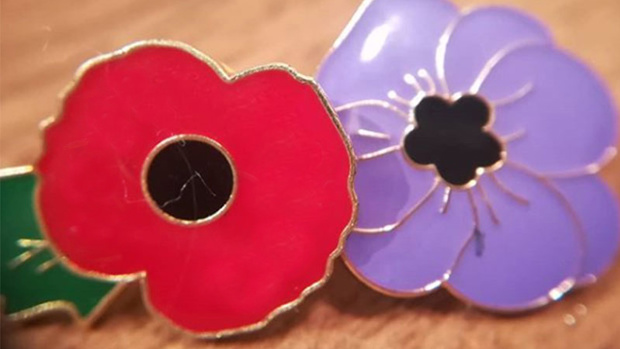The Remembrance Poppy: This is what the purple poppy represents...
- Publish Date
- Monday, 22 April 2024, 2:00PM

Have you ever seen a purple remembrance poppy and wondered what it represented? Well, wonder no more...
It symbolises all animals who have served and/or died during conflict. It is estimated that more than 8 million animals sacrificed their lives in World War I alone.
In 2018, the War Animal Memorial was unveiled at the National Army Museum in Waiouru and February 24 was designated Purple Poppy Day to remember and honour the animals that served and died in war and conflict and those that continue to serve.
Let us remember these brave animals, their deeds, and their sacrifices.
Scout Sergeant Major Paddy, a true shaggy-dog story
Paddy, an Irish Terrier born in Marton, started his military career almost by chance. He was a bit of a character accused of sheep-worrying. To save his life, his mistress offered him to the 7th (Wellington West Coast) Regiment. She may have also hoped, as many mothers do, that military discipline would make him a valuable member of society.
Sergeant Major Beaumont Woodhead, a professional soldier originally from the British Army and the acting Regimental Sergeant Major, felt he was the man to straighten Paddy out and gave him a comfortable home in Whanganui.

At the outbreak of war, Woodhead enlisted with the New Zealand Expeditionary Force (NZEF) and decided to try and take Paddy with him as an official mascot. Paddy, now with the rank of Private assembled with the men of the Wellington Infantry Battalion at the Awapuni Racecourse (Palmerston North) with Woodhead now appointed Company Sergeant Major of ‘A’ Company.
There was an order prohibiting pets on transports, but it was argued that Private Paddy was an authenticated pre-war mascot (on the strength of his worn collar plate) and therefore entitled to stay with the troops.
Colonel William Malone, in charge of the Wellington Battalion, still refused to let him board, but Paddy was smuggled onto the troopship Maunganui anyway. Following an appeal to the Brigade Major Paddy was granted permission to sail with the Main Body on October 16, 1914 and it was believed that Paddy was the only genuine mascot in the NZEF.
Paddy went missing once on board the Maunganui emerging from somewhere (no one could say for sure from where) on the second day at sea, sniffing the sea breeze and mightily pleased to be still among his fellow soldiers.
Paddy would race around the ship as they sailed to Egypt and his leather collar became worn and loose. Once they reached Colombo, Ceylon (now Sri Lanka) Woodhead agreed with Sergeant Major Harrison Wray, the other Sergeant Major attached to ‘A’ Company, to purchase a padlocked metal collar in the city.
They engraved ‘Paddy, Wellington Bn. NZEF’ and the two men decided to coin-toss for the old collar; Sergeant Major Wray won.
Paddy served with the men at the Suez in Egypt and was raring to go when they landed at Gallipoli on April 25, 1915. It is not clear how he got ashore, but once there the sounds of battle drove him wild. As bullets whizzed over his head he dropped to the ground in an initial state of shock. Nothing could have prepared him (or the men) for the horrors of war.
For the next week, he tore about through the scrub amongst the men where the bullets were thickest, barking and scuttling. During several attacks, he was at the front of the charge and on one occasion reached the enemy trenches before the men.
He barked at the Turks, much to their surprise, before racing back into the line. One night, he was found lying by a dead Kiwi soldier. It was initially thought he was also dead, but a gentle push with a boot evoked an ominous growl. Turning him over it was found he was quite unscathed but more than a little “dog tired”.
In early May, when the men of the Wellington Battalion headed to the fighting at Helles (battle at the Daisy Patch) Paddy was lost on the beach for several days (having attached himself to a British unit). Fortunately, one of the Brigade Staff who had been on the ship with him coming from New Zealand recognised him wandering around, picked him up and brought him back to the unit.
However, he was a different Paddy. He was almost deaf and was suffering from shell shock with the slightest noise sending him cowering to the ground. It appeared that the hell of Gallipoli had broken him; he was not the same happy dog that had left New Zealand only months prior.
After the evacuation of Gallipoli in December 1915, he regained some strength and vigour, likely from the familiar sights and smells of Egypt. He further improved when they set sail for England and then on to France. Once in France, his hearing improved and his mischievous swagger returned. He attached himself to the Quartermaster’s Staff, for the best food of course (like the old soldier he was).
As the war progressed, a much wiser and battle-hardened Paddy stayed with the Quartermaster. He was always with the rations, always at a reasonably safe distance behind the lines, and always in the best billets that could be found.
Promotion came rapidly to the old dog and when the war ended, he was a fully-fledged Scout Sergeant Major, wearing his red tailor-made coat with his name, Sergeant’s stripes and four blue chevrons signalling his years at war.
He then travelled to Germany as part of the occupying force before making it to England. A decision was made to get him back home to New Zealand and Lieutenant Colonel Bill Cunningham, who had commanded the Wellington West Coast men, appealed to the Army Department.
There was a ban on importing dogs from certain areas, but Cunningham was able to arrange for his return provided he quarantined in Britain for six months. He was placed in quarantine until February 1919 when the paperwork for his return journey to New Zealand was completed.
Every man in the Wellington Battalion knew of Paddy and to hear that he had survived the war and was returning home brought them great happiness. It was hard to believe that such a little dog could be so tough; he lived up to the spirit of the “fighting Irish” even if he was only an Irish Terrier.
However, an outbreak of rabies made Paddy’s return home nearly impossible. The Director General of Agriculture made an exception, saying Paddy could return home only if he lived at the Wellington Zoo. Cunningham, preferring to provide Paddy with a home himself, reluctantly agreed.
Sadly, Paddy never did return home. Further rabies scares in the early 1920s delayed his journey further. He was initially kept at the Royal Society for the Prevention of Cruelty to Animals (RSPCA) in London before being sent into the care of Mrs Jennetta Campbell Rogers in Devon.
In late 1922, when final plans were made for his return, it was decided Paddy was now too frail to make the long sea journey home to New Zealand. He stayed with Mrs Campbell Rogers until 1929 when he passed away peacefully. Mrs Campbell Rogers sent his second collar back to the Wellington Regiment with a letter, the last words stating:
“I should like the Regiment to know that Paddy’s last years (he must have been 16 when he died a short time ago) were as happy as care and kindness could make them … He was a well-known character, and his war service made him a heroic figure.”
Although he died a long way from home, this feisty mascot from Marton will always be a good boy.
- Scout Sergeant Major Paddy's story was republished with permission from the National Army Museum, Waiouru via NZ Herald.
Take your Radio, Podcasts and Music with you

